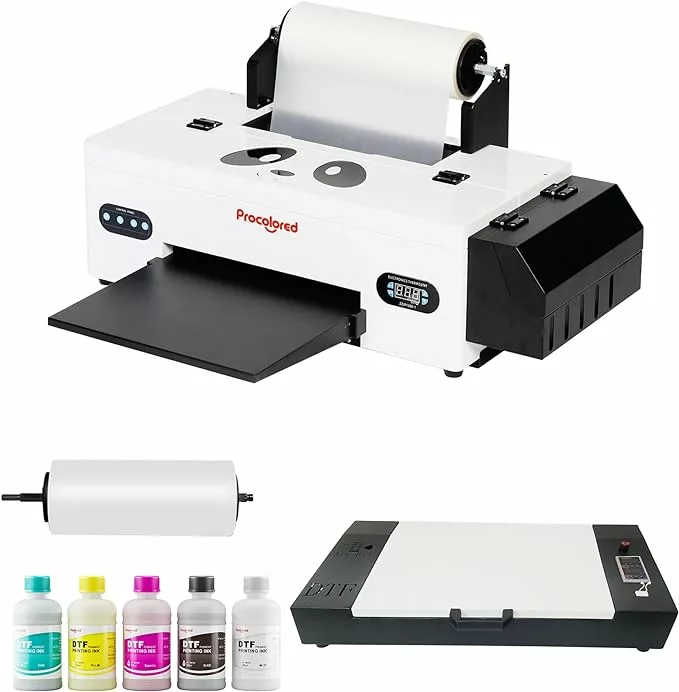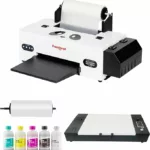
L1800 DTF Printer with Roll Feeder: Unleash Vibrant T-Shirt Designs
L1800 DTF Printer with Roll Feeder Quick Link
The L1800 DTF Printer with Roll Feeder has become a hot topic in the world of custom apparel creation. This printer utilizes Direct-to-Film (DTF) technology, a process that involves printing designs onto a special film and then heat-pressing them onto various fabrics, most commonly t-shirts. Whether you’re a seasoned business owner or a hobbyist with a creative spark, the L1800 promises vibrant prints and a streamlined workflow. But is it the right choice for you? This comprehensive review dives deep into the technical aspects, explores user experiences, and compares it to competitor products, empowering you to make an informed decision.
Unveiling the L1800: Technical Breakdown
For the tech-savvy buyer, understanding the L1800’s inner workings is crucial. This printer utilizes inkjet technology, similar to your home printer but with specialized features catering to DTF printing. Let’s dissect the core functionalities:
- Maximum Print Area: The L1800 boasts an impressive A3+ printing area (33cm x 48cm). This allows you to create large, impactful designs for t-shirts, hoodies, and even tote bags.
- Ink Cartridges: The printer employs a refillable ink cartridge system, typically offering six colors including white. This reduces long-term printing costs compared to disposable cartridges. However, refilling requires proper technique to avoid ink smudging or clogging.
- Roll Feeder: This is a game-changer for production efficiency. The roll feeder allows you to load PET film in a continuous format, eliminating the need to manually cut and feed individual sheets. This not only saves time but also minimizes material waste.
- White Ink Circulation System: White ink is notorious for clogging in inkjet printers. The L1800 addresses this with a dedicated circulation system that constantly agitates the white ink, preventing build-up and ensuring consistent application for vibrant white details on dark fabrics.
- Auto Heat Station: An optional feature on some models, the auto heat station preheats the film before printing. This can improve ink adhesion and overall print quality.
- Connectivity: The L1800 typically connects via USB, allowing you to send designs directly from your computer. While some users might prefer Wi-Fi connectivity, USB ensures a reliable and secure connection for printing.
Table of Contents
Click image to see other images and prices:
Beyond the Specs: User Experiences
Technical specifications paint a picture, but real user experiences offer valuable insights. Here’s a breakdown of what customers love and what might raise concerns:
Positive Reviews L1800 DTF Printer with Roll Feeder:
- Print Quality: Many users rave about the L1800’s ability to produce professional-grade prints. Colors are reported to be vivid and detailed, with excellent white ink performance on dark fabrics.
- Ease of Use: Compared to traditional DTF setups that require manual film feeding and heat pressing, the L1800 streamlines the process. The roll feeder and auto heat station (if included) are seen as significant improvements for faster production.
- Versatility: The DTF process allows printing on various fabrics beyond just t-shirts. Users report success with hoodies, hats, tote bags, and even shoes, making the L1800 a versatile tool for diverse creative projects.
Negative Reviews about L1800 DTF Printer with Roll Feeder:
- Learning Curve: While easier to operate than traditional DTF, there’s still a learning curve. Users may need to experiment with ink settings, film types, and heat press settings to achieve optimal results.
- Maintenance Costs: Replacing inks and maintaining the white ink circulation system can add to ongoing costs. The learning curve can also lead to wasted materials while users perfect their technique.
- Warranty: Some customer reviews express concerns about the warranty period being shorter than what they expect for a business investment. It’s crucial to check the specific warranty details before purchasing.
Considering the Competition: DTF vs. DTG
The L1800 represents the DTF (Direct-to-Film) printing technology. However, another popular option for t-shirt printing is DTG (Direct-to-Garment). Here’s a quick comparison to help you decide which might be a better fit:
- DTF: Prints onto a film that’s then heat-pressed onto the garment. Offers good compatibility with various fabrics, including those not suitable for DTG. Requires additional investment in heat press equipment.
- DTG: Prints directly onto the garment. Typically faster production speeds than DTF. Requires pre-treatment of some fabrics for optimal ink adhesion. Limited to garments compatible with DTG inks and heat.
Here’s a closer look at some competitor products to broaden your perspective:
- Epson SC-F2100: This DTG printer is a popular choice for businesses seeking high production speeds. It eliminates the need for film and heat pressing, but requires pre-treatment of some fabrics for optimal results. The SC-F2100 might have a higher initial investment but could be suitable for businesses needing large volume production.
- Brother GTX: Another DTG contender, the Brother GTX is known for its user-friendly software and reliable operation. However, it boasts a smaller print area compared to the L1800, which might limit your design possibilities.
Making an Informed Decision: Is the L1800 Right for You?
We’ve explored the technical aspects, user experiences, and competitor landscape. Now, the crucial question: Should you invest in the L1800 DTF Printer with Roll Feeder? Here are some factors to consider:
- Printing Needs: If you require high-quality prints on various fabrics, including those not compatible with DTG, the L1800’s versatility is a major advantage.
- Production Volume: For hobbyists or businesses with smaller print runs, the L1800’s efficiency is a plus. If you need high-volume production, a DTG printer like the SC-F2100 might be more suitable.
- Budget: Consider the initial investment for the printer, inks, heat press (if not included), and ongoing maintenance costs. Factor in the potential for wasted materials during the learning curve.
- Technical Expertise: While the L1800 streamlines the DTF process, there’s still a learning curve. If you’re comfortable with experimentation and troubleshooting, you can navigate it.
Final Thoughts: https://amzn.to/3U5nqq5
The L1800 DTF Printer with Roll Feeder offers a compelling solution for creating high-quality t-shirts and other custom apparel. Its ease of use, vibrant prints, and compatibility with various fabrics make it a strong contender, especially for those new to DTF printing. However, the shorter warranty, learning curve, and ongoing maintenance costs should be factored into your decision.
Take the Next Step:
Before making a purchase, thoroughly research the L1800 and similar DTF and DTG printers. Read additional reviews from verified buyers on platforms like Amazon [Amazon website] to gain insights into real-world experiences. Consider your specific needs, budget, and technical comfort level to determine the best fit for your creative endeavors. With the right information and a touch of research, you’ll be well on your way to printing stunning designs on your favorite fabrics.

